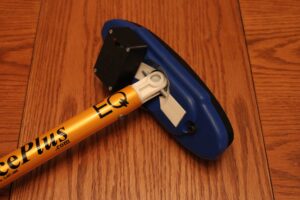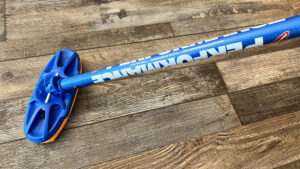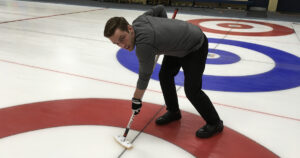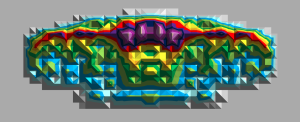Equipment

Instrumented Curling Brushes and the CurlSmart brush
I frequently receive questions about the instrumented brush that I use when testing athletes. An instrumented brush is a “game-changer” in the coaching of the sport of curling, because the effectiveness of an athlete cannot be determined statically (for example, by using a bathroom scale). Rather, brushing involves movement, and an instrumented brush is able to measure various characteristics of an athlete’s brushing profile to give essential guidance to a coach to help improve their technique. The instrumented brush that I use is a prototype developed by Dr. John Newhook of Dalhousie University, and is described in some detail in the article shown at right. In a nutshell, the brush captures (via a strain gauge) the vertical force generated through the handle at a sampling rate of 100 Hz. The force data from the brush is transmitted to a laptop Windows computer running proprietary software that (a) converts the values from the brush into “forces” in kilograms, for better understanding

Curling brushes – Try before you buy – Part Deux
On April 13th I’ll be one of the coaches at the Ontario Curling Council U18 Academy camp at the Dundas Valley Golf and Curling Club in Dundas, ON. In the first part of this article I mentioned that one of things I like to do when coaching at a camp is to bring along a large broom bag with an assortment of brushes from my collection, so that the athletes have an opportunity to try out various brushes that are different from the one they use regularly. It is unsurprising to me how frequently an athlete will profess a liking for a particular brush in my collection that is different from the one they have. Most often that difference relates to the handle, and not the brush pad. While debate over the utility of the various brush pads from the different manufacturers continues, what is frequently overlooked are the handles, and the characteristics of a given handle does impact the

OnForm adds multi-camera support
The latest version of the OnForm video analysis application, just released this week (March 18, 2024) on Apple devices now supports simultaneous multi-camera video recording from multiple devices (up to 3) on the same WIFI network. For curling coaches, being able to record simultaneous camera input of a curling delivery – for example, using a camera located behind the hack, and another in front of the athlete) can be exceedingly helpful. Other commercial applications support this functionality; Curling Canada demonstrated the use of the Switcher Studio application at the high-performance coaching summit in Edmonton in August, using three Apple iOS devices: one behind the hack, another at the side, and a third mounted on top of a sawhorse in front of the athlete. If you already use OnForm with a coaches’ license, you know the value to being able to not only record video but also annotate the video with markup or with voice-over: The disadvantage of the Switcher Studio

Curling brushes – Try before you buy – Part Un
No self-respecting golfer would simply walk into a golf pro shop or retail outlet to buy a new set of clubs without going through the process of getting fitted. Fitting is an assessment process that involves the analysis of a golfer’s swing and physiology to ensure that the golf clubs under consideration “fit” the player, enabling the player to strike the ball square in the middle of the club face with a shaft whose flex matches the player’s swing speed, among other trade-offs. A summary of factors involved in golf club fitting can be found in this article entitled “Clubfitting 101” by MyGolfSpy. While the MyGolfSpy article covers the details of club head variations that can suit different types of players and their style of game, the article also covers consideration of the choice of club shafts, particularly: shaft flex. Simplistically, higher swing speeds warrant stiffer club shafts though this is an overgeneralization. Other factors include release pattern and shaft

Pressure distribution in selected curling brush heads
This research is joint work with Dr. John Newhook, Dr. Michel Ladouceur, and Dr. Ryan Frayne of Dalhousie University in Halifax. John is a Professor of Civil Engineering and the Dean of Engineering at Dalhousie, while Michel and Ryan are assistant professors in the Kinesiology department of the School of Health and Human Performance at Dalhousie. At the 2022 North American Conference on Biomechanics (NACOB) held the week of August 22-25 in Ottawa, we presented our initial work that compared a variety of commercial brush heads in how they distributed pressure across their pads in a static laboratory setup. Forces and pressures were recorded using two 3200E Tekscan (Tekscan Inc., Boston, MA) pressure sensors affixed to the top of an AMTI BP400600 force plate (AMTI Inc., Watertown MA), with the sensel areas abutted. CONFORMat Research software (version 7.1: Tekscan Inc.) was used to collect the pressure sensor data, which was recorded at a frequency of 100 Hz. Our results are

Zeroing a PT-2 Smartbroom
Even though the PT-2 has been discontinued by Canadian Curling Tools in favour of their new “Smartbroom” device, a number of curling associations and individual coaches continue to use PT-2 instrumented brushes with their teams. A characteristic of the PT-2 that coaches must be aware of is the frequent need to “zero” the PT-2 brush to ensure that the force readings from the brush are as accurate as possible. The need for this is because the PT-2’s load sensors are cemented into the brush’s EQ brush pad, and over-tightening of the bolts that fix the brush pad in place can result in skewed measurements. As I’ve been asked a few times about the zeroing method for the PT-2 I decided to post this article. PT-2 documentation is no longer available on the Canadian Curling Tools website. To zero a PT-2 brush, follow these steps: Ensure that the brush head is plugged into the PT-2’s display unit, and the unit is